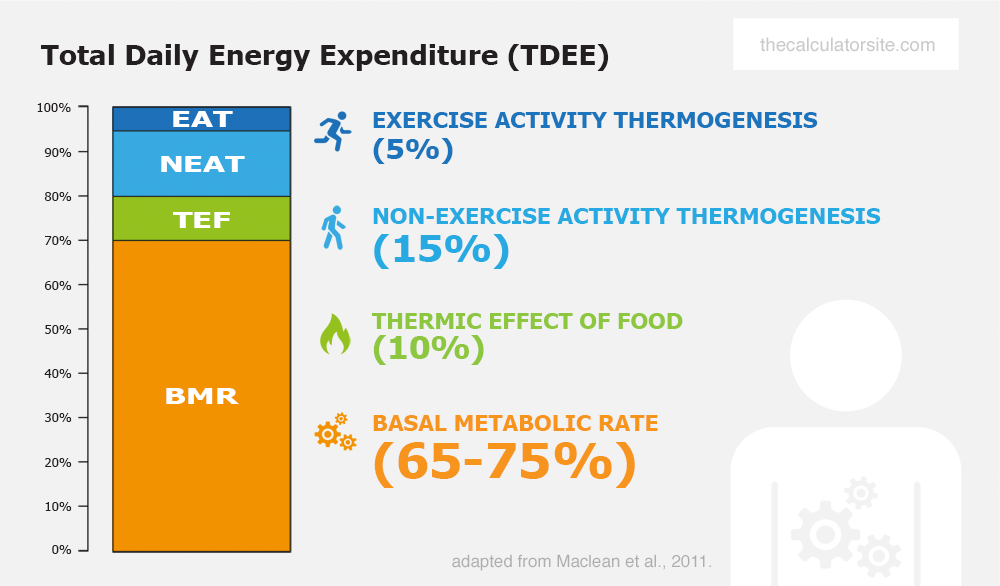

Health calculator tdee plus#
For weight gain: Calories per day = TDEE plus 500.For weight loss: Calories per day = TDEE minus 500.Knowing your TDEE also means that you can easily calculate how many calories you need to eat in order to lose weight or gain weight. Since maintaining a healthy bodyweight is linked with improved health across a range of markers, TDEE can be a useful tool for looking after your health. Why Does TDEE Matter?īy calculating your TDEE, you know exactly how many calories it takes per day to maintain your bodyweight. It stands for Total Daily Energy Expenditure, and it’s the amount of calories that you need per day in order to maintain your current bodyweight once exercise and lifestyle have been factored in. TDEE is, without exaggeration, the most useful tool you’ll come across for weight management, weight loss and muscle building. As such, in addition to monitoring calorie intake, it is important to maintain levels of fibre intake as well as other nutritional necessities to balance the needs of the body.Kcal per day What is Total Daily Energy Expenditure (TDEE)? Depriving the body of the nutrients it requires as part of heavily unhealthy diets can have serious detrimental effects, and weight lost in this manner has been shown in some studies to be unsustainable, since the weight is often regained in the form of fat (putting the participant in a worse state than when beginning the diet). Furthermore, particularly when exercising in conjunction with dieting, maintaining a good diet is important, since the body needs to be able to support its metabolic processes and replenish itself. Excessive weight loss can also be due to dehydration, which is unhealthy. Losing more than 2 pounds a week will likely involve muscle loss, which in turn lowers BMR, since more muscle mass results in higher BMR. It is inadvisable to lower calorie intake by more than 1,000 calories per day, as losing more than 2 pounds per week can be unhealthy, and can result in the opposite effect in the near future by reducing metabolism. It is important to remember that proper diet and exercise is largely accepted as the best way to lose weight. For example, if a person has an estimated allotment of 2,500 calories per day to maintain body-weight, consuming 2,000 calories per day for one week would theoretically result in 3,500 calories (or 1 pound) lost during the period. As such, in order to lose 1 pound per week, it is recommended that 500 calories be shaved off the estimate of calories necessary for weight maintenance per day.

1 pound, or approximately 0.45 kg, equates to about 3,500 calories. This value is multiplied by an activity factor (generally 1.2-1.95), dependent on a person's typical levels of exercise, in order to obtain a more realistic value for maintaining body-weight (since people are less likely to be at rest throughout the course of an entire day). The value obtained from these equations is the estimated number of calories a person can consume in a day to maintain their body-weight, assuming they remain at rest.

Of these equations, the Mifflin-St Jeor Equation is considered the most accurate equation for calculating BMR with the exception that the Katch-McArdle Formula can be more accurate for people who are leaner and know their body fat percentage. The Katch-McArdle Formula is slightly different in that it calculates resting daily energy expenditure (RDEE), which takes lean body mass into account, something that neither the Mifflin-St Jeor nor the Harris-Benedict Equation do. The Mifflin-St Jeor Equation also calculates BMR, and has been shown to be more accurate than the revised Harris-Benedict Equation. It was revised in 1984 to be more accurate and was used up until 1990, when the Mifflin-St Jeor Equation was introduced. The Harris-Benedict Equation was one of the earliest equations used to calculate basal metabolic rate (BMR), which is the amount of energy expended per day at rest. This Calorie Calculator is based on several equations, and the results of the calculator are based on an estimated average. In other words, if you laid in bed all day doing nothing else, then you would need to eat at least the number of calories roughly equal to your BMR in order to maintain your normal body functions. Basal metabolism includes most of the involuntary things the human body does to support life – such as breathing, blood circulation, body temperature regulation, nervous system operations, etc., but not the extra energy needed for any additional physical activity such as gym exercise. The rate at which energy (calories) is used for the essential life functions is called Basal Metabolic Rate (BMR).


 0 kommentar(er)
0 kommentar(er)
